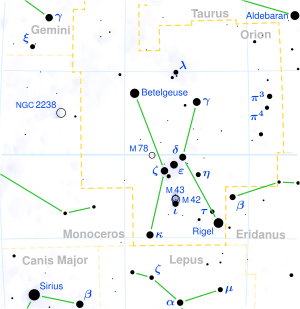Pi5 Orionis

| |
| Observation data Epoch J2000.0 Equinox J2000.0 (ICRS) | |
|---|---|
| Constellation | Orion |
| Right ascension | 04h 54m 15.09604s[1] |
| Declination | +02° 26′ 26.4231″[1] |
| Apparent magnitude (V) | 3.69[2] |
| Characteristics | |
| Spectral type | B2 III[3] |
| U−B color index | −0.81[2] |
| B−V color index | −0.18[2] |
| Variable type | Ellipsoidal[4] |
| Astrometry | |
| Radial velocity (Rv) | +23.4[5] km/s |
| Proper motion (μ) | RA: +0.55[1] mas/yr Dec.: +0.61[1] mas/yr |
| Parallax (π) | 2.43 ± 0.39[1] mas |
| Distance | approx. 1,300 ly (approx. 410 pc) |
| Orbit[6] | |
| Period (P) | 3.7005 d |
| Eccentricity (e) | 0.0000 |
| Periastron epoch (T) | 2417921.64±0.01 JD |
| Semi-amplitude (K1) (primary) | 57.88±1.07 km/s |
| Details | |
| π5 Ori A | |
| Mass | 12.5±0.6[7] M☉ |
| Luminosity | 11,262[8] L☉ |
| Surface gravity (log g) | 3.51[9] cgs |
| Temperature | 14,496[8] K |
| Metallicity [Fe/H] | −0.28[9] dex |
| Rotational velocity (v sin i) | 90[10] km/s |
| Age | 15.8±0.2[7] Myr |
| Other designations | |
Pi5 Orionis (π5 Ori, π5 Orionis) is a binary star system in the constellation Orion. It has an apparent visual magnitude of 3.69,[2] which is bright enough to be visible to the naked eye on a clear night. Based upon an annual parallax shift of 2.43 mas,[1] it is around 1,300 light years distant from the Sun.
This is a single-lined[3] spectroscopic binary star system in a circular orbit with an orbital period of 3.7005 days.[6] It is an ellipsoidal variable, which means the orbit is sufficiently close that the shapes of the components are being distorted by their mutual gravitation. This is causing the visual magnitude of the system to vary regularly by 0m.05 over the course of each orbit, as the orientation of the stars change with respect to the Earth.[4]
The primary component is a B-type giant star with a stellar classification of B2 III.[3] It is only 16[7] million years old and spins with a projected rotational velocity of 90 km/s.[10] Pi5 Orionis has about 12.5 times the mass of the Sun and radiates 11,262[8] times the solar luminosity from its outer atmosphere at an effective temperature of 14,496 K.[8]
References
- 1 2 3 4 5 6 van Leeuwen, F. (2007), "Validation of the new Hipparcos reduction", Astronomy and Astrophysics, 474 (2): 653–664, arXiv:0708.1752
 , Bibcode:2007A&A...474..653V, doi:10.1051/0004-6361:20078357.
, Bibcode:2007A&A...474..653V, doi:10.1051/0004-6361:20078357. - 1 2 3 4 Crawford, D. L.; et al. (1971), "Four-color, H-beta, and UBV photometry for bright B-type stars in the northern hemisphere", The Astronomical Journal, 76: 1058, Bibcode:1971AJ.....76.1058C, doi:10.1086/111220.
- 1 2 3 Chini, R.; et al. (2012), "A spectroscopic survey on the multiplicity of high-mass stars", Monthly Notices of the Royal Astronomical Society, 424 (3): 1925, arXiv:1205.5238
 , Bibcode:2012MNRAS.424.1925C, doi:10.1111/j.1365-2966.2012.21317.x.
, Bibcode:2012MNRAS.424.1925C, doi:10.1111/j.1365-2966.2012.21317.x. - 1 2 Morris, S. L. (August 1985), "The ellipsoidal variable stars", Astrophysical Journal, Part 1, 295: 143−152, Bibcode:1985ApJ...295..143M, doi:10.1086/163359.
- ↑ Evans, D. S. (June 20–24, 1966), "The Revision of the General Catalogue of Radial Velocities", in Batten, Alan Henry; Heard, John Frederick, Determination of Radial Velocities and their Applications, Proceedings from IAU Symposium no. 30, University of Toronto: International Astronomical Union, Bibcode:1967IAUS...30...57E.
- 1 2 Pourbaix, D.; et al. (2004), "SB9: The ninth catalogue of spectroscopic binary orbits", Astronomy & Astrophysics, 424 (2): 727, arXiv:astro-ph/0406573
 , Bibcode:2004A&A...424..727P, doi:10.1051/0004-6361:20041213.
, Bibcode:2004A&A...424..727P, doi:10.1051/0004-6361:20041213. - 1 2 3 Tetzlaff, N.; et al. (January 2011), "A catalogue of young runaway Hipparcos stars within 3 kpc from the Sun", Monthly Notices of the Royal Astronomical Society, 410 (1): 190–200, arXiv:1007.4883
 , Bibcode:2011MNRAS.410..190T, doi:10.1111/j.1365-2966.2010.17434.x.
, Bibcode:2011MNRAS.410..190T, doi:10.1111/j.1365-2966.2010.17434.x. - 1 2 3 4 McDonald, I.; et al. (2012), "Fundamental Parameters and Infrared Excesses of Hipparcos Stars", Monthly Notices of the Royal Astronomical Society, 427 (1): 343–57, arXiv:1208.2037
 , Bibcode:2012MNRAS.427..343M, doi:10.1111/j.1365-2966.2012.21873.x.
, Bibcode:2012MNRAS.427..343M, doi:10.1111/j.1365-2966.2012.21873.x. - 1 2 Soubiran, C.; et al. (June 2010), "The PASTEL catalogue of stellar parameters", Astronomy and Astrophysics, 515: A111, arXiv:1004.1069
 , Bibcode:2010A&A...515A.111S, doi:10.1051/0004-6361/201014247.
, Bibcode:2010A&A...515A.111S, doi:10.1051/0004-6361/201014247. - 1 2 Abt, Helmut A.; Boonyarak, Chayan (November 2004), "Tidal Effects in Binaries of Various Periods", The Astrophysical Journal, 616 (1): 562−566, Bibcode:2004ApJ...616..562A, doi:10.1086/423795.
- ↑ "pi.05 Ori -- Spectroscopic binary", SIMBAD Astronomical Database, Centre de Données astronomiques de Strasbourg, retrieved 2016-11-18.
External links
- Kaler, James B. (February 6, 2009), "Pi-5 Orionis", Stars, University of Illinois, retrieved 2016-11-22.